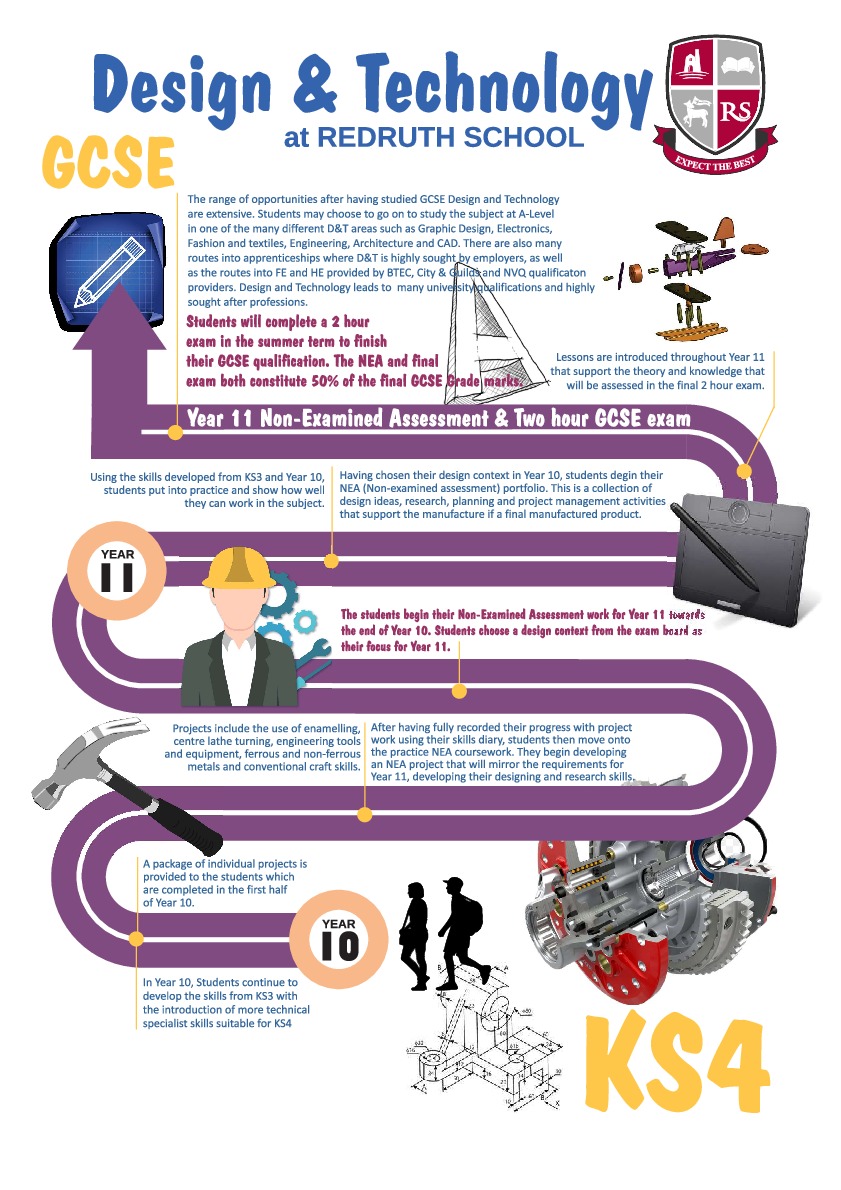- Home
- Students
- Subject Information
- Design Technology
- facebookShare this page on Facebook
- twitterTweet this page
- pinterestPin this page
Design Technology
Head of Faculty: Mrs Chloe Smith
csmith@redruth.cornwall.sch.uk
Design Technology curriculum intent
In Design and Technology students combine practical and technological skills with creative thinking to design and make a range of products from a variety of materials. Our student curriculum is highly aspirational: we instil life skills in students which are vital for their success both in life and work. This is complemented by extensive links to careers in an ever-changing world where technological advancements are likely to play a huge role. We support the building of strong subject knowledge with inter-disciplinary links to enable students to research, design, make, evaluate and constantly improve. Students are encouraged to think creatively, solve problems and work productively, both in teams and independently. Through this programme of study, project management skills, portfolio skills and independent learning skills are honed. We are supporting the development of future designers, engineers and entrepreneurs through a curriculum which seeks to engage and inspire. We aim to nurture resourceful, innovative, enterprising, capable citizens of the future, whose knowledge includes an understanding of nutrition and healthy choices, an appreciation for the needs and wants of different cultures and demographics, and careful consideration of sustainability, including aspects such as food miles and product/material types.

What does the Key Stage 3 Design Technology curriculum look like?
In Year 7, students are introduced to the workshops, which include different materials and how to use the workshop machines safely. The students are introduced to developing creativity and developing three-dimensional drawing techniques into three dimensional outcomes. The students will then evaluate their work and look at how they could modify and develop the idea. The students will look at different areas of design technology and a focus on careers is included. From an introduction to architecture and product design the students will use a variety of skills which will also include computer-aided design (CAD) and computer-aided manufacture (CAM) which incorporate the laser cutter.
In Year 8, the students will develop the knowledge from year 7, incorporating more aspects of the design process, linking to the GCSE style approach where the students will look at research, designing, making and evaluating. The projects introduce new skills like electronics and graphic design alongside product design. Design technology is vast and students need to be aware of all the different possibilities that the subject can lead to.
In Year 9, the emphasis is looking at existing designers and design movements which again is linked to the GCSE curriculum. The students will base their ideas on looking at these sources as an avenue for their own creations and the how can they can use this research as a basis for their own designs. These projects are done more like a GCSE project so the students have a better understanding of what is expected of them at Key Stage 4.
What does the Key Stage 4 Design Technology curriculum look like?
In Year 10 and 11 Product Design GCSE, students who have chosen the subject will now complete a variety of different short design and make projects which make them feel more comfortable with the whole design process. Students will learn technical drawing by hand and also on the computer. They will have more chance to develop the designs using the machines and tools, thus increasing their confidence and also the possibilities of what they can make for their major project. During this time the students will develop their theory knowledge to help with their revision for the final unit test which is worth 50%, as we go through all the different sections of the specification. After Easter the students will then start the AQA design technology major project which is worth 50% of their final grade. The students will finish the project in February and then all attention will focus on preparation for their exam.
In Year 10 and 11, the engineering course is split into three sections. Section 1 is taken in Year 10 and starts in September where the students are given a design brief by the exam board and will need to go through the whole design process, which will enable them to deliver a final outcome to be completed by May. During this time the students will also be undertaking revision for the exam section at the end of year 11. Students will use the tools and machines in the workshop and also develop their design three dimensionally using the computer programme onshape, which is a free 3D computer modelling programme they can also use at home. Section 2 will start in year 11, when the students are given a new design brief by the exam board and will need to come to a final conclusion in regards to what the brief entails. This will also need to be completed by the following May. During year 11 exam focus is key so they are confident and ready. Finally, Section 3 is the exam unit.
How can you support Technology learning at home?
-
Support your child with their homework and ensure that your child has sufficient time to complete their homework consistently.
- At all key stages asking your son/daughter to talk about their lessons and what they are learning – this will help consolidate their understanding and develop their ideas and knowledge.
-
Collect articles from magazines/leaflets/watch programmes on design and engineering.
Students
- Careers
- Combined Cadet Force
- Duke of Edinburgh's Award
- Extra-Curricular Clubs, Trips & Activities
- Future4 curriculum
- Learning Resource Centre (Library)
- More Able Provision
- Our House System
- Pastoral
- Student Portal & Class Charts
- Subject Information
- Student Voice
- Student Wellbeing
- Work Experience


